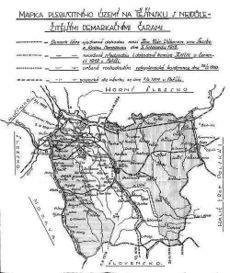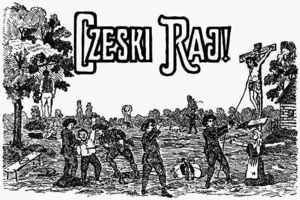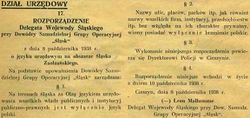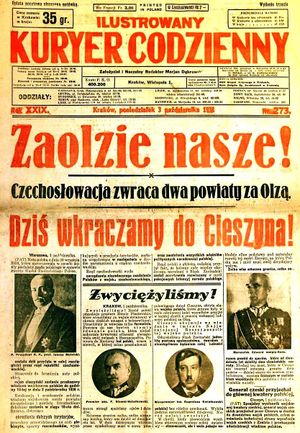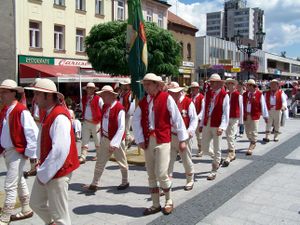زاؤلجى
| ||
|---|---|---|
Zaolzie [zaˈɔlʑɛ] (![]() استمع) is the Polish name for an area now in the Czech Republic which was disputed between interwar Poland and Czechoslovakia. The name means "lands beyond the Olza River"; it is also called Śląsk zaolziański, meaning "trans-Olza Silesia". Equivalent terms in other languages include Zaolší (Zaolží) in Czech and Olsa-Gebiet in German. The Zaolzie region was created in 1920, when Cieszyn Silesia was divided between Czechoslovakia and Poland. Zaolzie forms the eastern part of the Czech portion of Cieszyn Silesia. The division did not satisfy any side, and persisting conflict over the region led to its annexation by Poland in October 1938, following the Munich Agreement. After German invasion of Poland in 1939, the area became a part of Nazi Germany until 1945. After the war, the 1920 borders were restored.
استمع) is the Polish name for an area now in the Czech Republic which was disputed between interwar Poland and Czechoslovakia. The name means "lands beyond the Olza River"; it is also called Śląsk zaolziański, meaning "trans-Olza Silesia". Equivalent terms in other languages include Zaolší (Zaolží) in Czech and Olsa-Gebiet in German. The Zaolzie region was created in 1920, when Cieszyn Silesia was divided between Czechoslovakia and Poland. Zaolzie forms the eastern part of the Czech portion of Cieszyn Silesia. The division did not satisfy any side, and persisting conflict over the region led to its annexation by Poland in October 1938, following the Munich Agreement. After German invasion of Poland in 1939, the area became a part of Nazi Germany until 1945. After the war, the 1920 borders were restored.
Historically, the largest specified ethnic group inhabiting this area were those identifying as Poles.[1] Under Austrian rule, Cieszyn Silesia was initially divided into three (Bielitz, Friedek and Teschen), and later into four districts (plus Freistadt). One of them, Frýdek, had a mostly Czech population, the other three were mostly inhabited by Poles.[2][3] During the 19th century the number of ethnic Germans grew. After declining at the end of the 19th century,[4] at the beginning of the 20th century and later from 1920 to 1938 the Czech population grew significantly (mainly as a result of immigration and the assimilation of locals) and Poles became a minority, which they are to this day. Another significant ethnic group were the Jews, but almost the entire Jewish population was murdered during World War II.
In addition to the Polish, Czech and German national orientations there was another group living in the area, the Ślązakowcy, who claimed a distinct Silesian national identity. This group enjoyed popular support throughout the whole of Cieszyn Silesia although its strongest supporters were among the Protestants in eastern part of the Cieszyn Silesia (now part of Poland) and not in Zaolzie itself.[5]
Decision time (1918–1920)
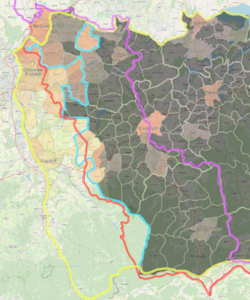
Cieszyn Silesia was claimed by both Poland and Czechoslovakia: the Polish Rada Narodowa Księstwa Cieszyńskiego made its claim in its declaration "Ludu śląski!" of 30 October 1918, and the Czech Zemský národní výbor pro Slezsko did so in its declaration of 1 November 1918.[6]
1918-19
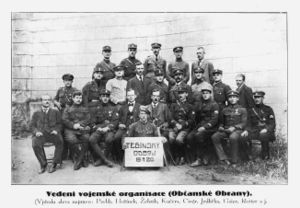
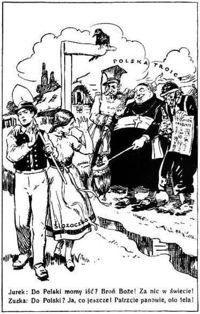
Part of Czechoslovakia (1920–1938)
Part of Poland (1938–1939)
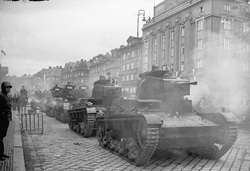
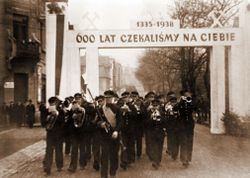
World War II
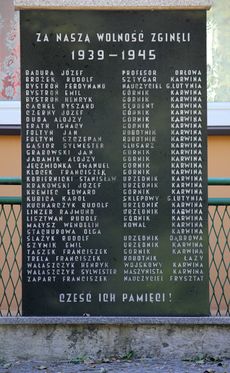
Since 1945
In the European Union
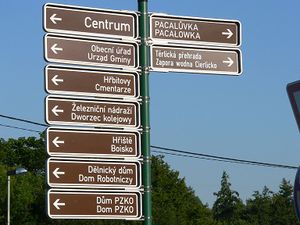

Census data
Ethnic structure of Zaolzie based on census results:
| Year | Total | Poles | Czechs | Germans | Slovaks |
|---|---|---|---|---|---|
| 1880[4] | 94,370 | 71,239 | 16,425 | 6,672 | – |
| 1890[4] | 107,675 | 86,674 | 13,580 | 7,388 | – |
| 1900[4] | 143,220 | 115,392 | 14,093 | 13,476 | – |
| 1910[4] | 179,145 | 123,923 | 32,821 | 22,312 | – |
| 1921[7] | 177,176 | 68,034 | 88,556 | 18,260 | – |
| 1930[8] | 216,255 | 76,230 | 120,639 | 17,182 | – |
| 1939[9] | 213,867 | 51,499 | 44,579 | 38,408 | – |
| 1950[10] | 219,811 | 59,005 | 155,146 | – | 4,388 |
| 1961[10] | 281,183 | 58,876 | 205,785 | – | 13,233 |
| 1970[11] | 350,825 | 56,075 | 263,047 | – | 26,806 |
| 1980[10] | 366,559 | 51,586 | 281,584 | – | 28,719 |
| 1991[10] | 368,355 | 43,479 | 263,941 | 706 | 26,629 |
Sources: Zahradnik 1992, 178–179. Siwek 1996, 31–38.
انظر أيضاً
Footnotes
- ^ Zahradnik 1992, 16–17.
- ^ Watt 1998, 161.
- ^ Piotr Stefan Wandycz. France and Her Eastern Allies, 1919-1925: French-Czechoslovak-Polish Relations from the Paris Peace Conference to Locarno. University of Minnesota Press. 1962. pp. 75, 79
- ^ أ ب ت ث ج The 1880, 1890, 1900 and 1910 Austrian censuses asked people about the language they use. (Siwek 1996, 31.)
- ^ Hannan 1996, 47.
- ^ Gawrecká 2004, 21.
- ^ The 1921 Czechoslovak census asked people about their native language. (Siwek 1996, 32.)
- ^ People could declare a nationality other than that indicated by their native language. (Siwek 1996, 32.)
- ^ The German occupational census based nationality on self-declaration of citizens. The census was distorted by the occupational regime. (Siwek 1996, 32.)
- ^ أ ب ت ث The 1950, 1961, 1980 and 1991 Czechoslovak censuses based nationality on self-declaration of citizens. (Siwek 1996, 37–38.)
- ^ The 1970 Czechoslovak census asked people about their native language. (Siwek 1996, 37.)
References
- Długajczyk, Edward (1993). Tajny front na granicy cieszyńskiej. Wywiad i dywersja w latach 1919–1939. Katowice: Śląsk. ISBN 83-85831-03-7.
- Gabal, Ivan; collective (1999). Etnické menšiny ve Střední Evropě. Praha: G plus G; supported by the Nadace rozvoje občanské společnosti of the European Commission. ISBN 80-86103-23-4.
- Gawrecká, Marie (2004). Československé Slezsko mezi světovými válkami 1918–1938. Opava: Silesian University in Ostrava. ISBN 80-7248-233-5.
- Hannan, Kevin (1996). Borders of Language and Identity in Teschen Silesia. New York: Peter Lang. ISBN 0-8204-3365-9.
- Hannan, Kevin (1999). "Language and Ethnicity among Students in Teschen Silesia". Nationalities Papers. 27 (2): 191–203. doi:10.1080/009059999109028.
- jot-Drużycki, Jarosław (2015). Hospicjum Zaolzie. Wędrynia: Wydawnictwo Beskidy. OCLC 995384642.
- Kovtun, Jiří (2005). Republika v nebezpečném světě; Éra prezidenta Masaryka 1918–1933. Praha: Torst; published in co-operation with Ministry of Culture of the Czech Republic. ISBN 80-7215-254-8.
- Mamatey, Victor S.; Radomír Luža (1973). A history of the Czechoslovak Republic 1918–1948. Princeton, New Jersey: Princeton University Press. ISBN 0-691-05205-0.
- Panic, Idzi (2002). Poczet Piastów i Piastówien cieszyńskich (in Polish). Cieszyn: Urząd Miejski. ISBN 83-917095-4-X. OCLC 55650394.
{{cite book}}: CS1 maint: unrecognized language (link)
- Siwek, Tadeusz (1996). Česko-polská etnická hranice. Ostrava: Filozofická fakulta Ostravské univerzity. ISBN 80-7042-457-5.
- Szymeczek, Józef (2008). "Polacy na Zaolziu". In Janusz Spyra (ed.). Śląsk Cieszyński. Granice – przynależność – tożsamość. Cieszyn: Muzeum Śląska Cieszyńskiego. pp. 63–72. ISBN 978-83-922005-4-3.
- Watt, Richard M. (1998). Bitter Glory. Poland and its fate 1918–1939. New York: Hippocrene Books. p. 511. ISBN 0-7818-0673-9.
- Žáček, Rudolf (2004). Dějiny Slezska v datech. Praha: Libri. ISBN 80-7277-172-8.
- Zahradnik, Stanisław; Marek Ryczkowski (1992). Korzenie Zaolzia. Warszawa – Praga – Trzyniec: PAI-press. OCLC 177389723.
- "Zaolzie". Nowa Encyklopedia Powszechna PWN. Vol. VI. Warszawa: PWN. 1997. ISBN 83-01-11969-1.
Further reading
- Kazimierz Badziak, Giennadij Matwiejew and Paweł Samuś (1997). "Powstanie" na Zaolziu w 1938 r.: Polska akcja specjalna w świetle dokumentów Oddziału II Sztabu Głównego WP. Warszawa: ADIUTOR. ISBN 83-86100-21-4.
- Kaszper, Roman; Małysz, Bohdan (editors) (2009). Poláci na Těšínsku (PDF). Český Těšín: Kongres Poláků v České republice. ISBN 978-80-87381-00-7. Archived from the original (PDF) on 18 يوليو 2011.
{{cite book}}:|first2=has generic name (help)
وصلات خارجية
- (إنگليزية) Jarosław Jot-Drużycki: Poles living in Zaolzie identify themselves better with Czechs". European Foundation of Human Rights. 3 September 2014.
- (Polish) Documents and photographs about the situation in Zaolzie in 1938
- (التشيكية) Interview of professor Jerzy Tomaszewski by Aleksander Kaczorowski
- Pages using gadget WikiMiniAtlas
- Use dmy dates from February 2012
- Articles with hatnote templates targeting a nonexistent page
- CS1 errors: generic name
- Coordinates on Wikidata
- Cieszyn Silesia
- Czech Republic–Poland border
- Czechoslovakia–Poland border
- Czechoslovakia–Poland relations
- History of Czech Silesia
- Moravian-Silesian Region
- Polish minority in Zaolzie
- Territorial disputes of Czechoslovakia
- Territorial disputes of Poland
